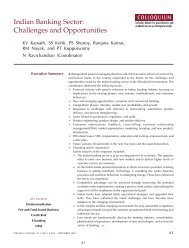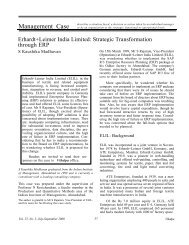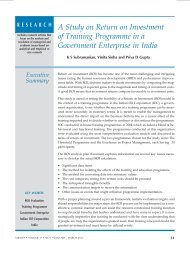Kudremukh Iron Ore Company Limited (KIOCL): The Death ... - Vikalpa
Kudremukh Iron Ore Company Limited (KIOCL): The Death ... - Vikalpa
Kudremukh Iron Ore Company Limited (KIOCL): The Death ... - Vikalpa
You also want an ePaper? Increase the reach of your titles
YUMPU automatically turns print PDFs into web optimized ePapers that Google loves.
However, there was a serious space constraint for storing<br />
the resulting tailings. <strong>The</strong> Lakya Dam was full and<br />
increasing the production or using primary ore which<br />
had only 27 per cent iron content warranted more space<br />
to store the waste. <strong>The</strong>refore, the company floated the idea<br />
of constructing a new dam on the west side of the mine<br />
site at Kachige Hole that was within the leased area.<br />
NIRCON, a Chennai-based consultant, examined the<br />
proposal and confirmed that it was feasible. A public<br />
hearing was scheduled on the environmental impact<br />
assessment of the new dam construction. Many NGOs<br />
were present during the hearing. All of them opposed the<br />
idea of construction of a new dam by the company. All<br />
further action got stalled.<br />
With a view to diversify its range of products, in 1987, the<br />
company commissioned a pellet plant at Mangalore with<br />
an annual capacity of 3.6 million tonnes. As a captive<br />
unit, it added value to the company’s products but its<br />
fortunes were closely tied to the <strong>Kudremukh</strong> mine because<br />
the technology was meant to process magnetite and not<br />
hematite. It was also proposed to produce pig iron at<br />
Mangalore and a joint venture company was launched to<br />
set up the plant. <strong>KIOCL</strong> also planned to establish a coke<br />
oven plant at Karwar, another port town 400 kms to the<br />
north of <strong>Kudremukh</strong>. <strong>The</strong> proposal was approved by the<br />
state government. In addition, the company proposed to<br />
manufacture clay tiles with the muck in Lakya Dam, and<br />
produce packaged drinking water using the unpolluted<br />
stream water abundantly available in <strong>Kudremukh</strong>. Both<br />
projects were found technically feasible, but with the<br />
market being saturated, the outcome seemed uncertain.<br />
<strong>KIOCL</strong> did not pursue the ideas further.<br />
Trouble Begins Afar and Spreads<br />
For three decades after gaining Independence, India’s<br />
focus was on accelerated economic development using<br />
available resources like land, water, minerals, etc. <strong>The</strong><br />
country needed foreign exchange for capital investment,<br />
import bill funding, and technology purchases. However,<br />
the fallout of the ill-planned developments began to show<br />
up at the national level. Conservation consciousness<br />
increa-sed in India due to the ongoing international<br />
events, and national action to contain the consequences<br />
of reckless industrialization slowly began to take root.<br />
First in place was the Wildlife (Protection) Act, 1972 under<br />
which biodiversity-rich areas like Western Ghats were to<br />
get better protection and National Parks and Sanctuaries<br />
124<br />
were to be constituted. Action on the provisions of this<br />
legislation began many years later. <strong>The</strong> formation of the<br />
<strong>Kudremukh</strong> National Park was a consequence of some of<br />
these unfolding phenomena. <strong>The</strong> intention to constitute<br />
this park was published in the official gazette in 1987<br />
and final notification was issued in June 2001.<br />
<strong>The</strong> second landmark legislation was the two-page Forest<br />
(Conservation) Act, 1980. This was an extraordinary Act<br />
that centralized the powers for diverting forest lands in<br />
the hands of the central government. Complex issues were<br />
involved in implementing the provisions of this Act and<br />
the checkered political establishment was somewhat lax<br />
in its implementation. A number of issues started reaching<br />
the courts. By 1995, the Supreme Court of India decided<br />
to get involved in a big way to sort out such issues and<br />
constituted a separate Green Bench. This Bench opened<br />
the doors to all pending issues and allowed them to be<br />
brought up and placed on its table. Many interim<br />
directions were issued on a range of forest-related issues<br />
and one of them concerned mining in national parks. <strong>The</strong><br />
court wanted that pending final notifications of the<br />
national parks be issued expeditiously. It also imposed a<br />
ban on mining in national parks. This hit the <strong>KIOCL</strong><br />
tangentially in the beginning but directly later on.<br />
<strong>The</strong> third important legislation was the Environmental<br />
(Protection) Act, 1986 which fixed standards for ambient<br />
environmental factors and imposed limits on pollution<br />
loads. An elaborate administrative set up of state and<br />
central pollution control boards came into existence to<br />
implement the provisions of this Act. <strong>The</strong> Act has<br />
undergone extensive amendments over time and covers<br />
almost every industry. <strong>The</strong> Supreme Court constituted an<br />
empowered committee under this Act to scrutinize almost<br />
every subject matter relating to the above three Acts and<br />
advise the Court. <strong>The</strong> special Green Bench that was<br />
constituted in the Supreme Court duly considered such<br />
advice before passing judgments. It is generally observed<br />
that the Court is strongly in favour of protecting the<br />
ecology, environment, and biodiversity and hence<br />
delivered tough verdicts.<br />
At the time the <strong>KIOCL</strong> mining contract was firmed up in<br />
1967, neither the Wildlife Protection Act (1972) nor the<br />
Forest (Conservation) Act, 1980 or the Environmental<br />
Protection Act (1986) were in force. <strong>The</strong> company was<br />
started in an era when development was the mantra and<br />
nothing else mattered as much. <strong>KIOCL</strong> invested USD 220<br />
KUDREMUKH IRON ORE COMPANY LIMITED (<strong>KIOCL</strong>): THE DEATH KNELL AND BEYOND





